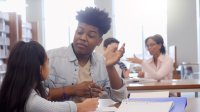How to Prepare Students to Learn by Teaching
Strategies for having older students teach younger ones, shared by a teacher at a high school career academy for future teachers.
Your content has been saved!
Go to My Saved Content.I’m the lead teacher of a high school Academy of Education—the students in my class are learning about becoming educators themselves. These students have a unique opportunity: They get to work with the children at our on-campus preschool, so they have a chance to practice teaching without leaving the building.
I use the state preschool curriculum to help my students fill in gaps in their own learning—they have shown improvement in reading, for example, after reviewing and teaching vowel-pattern rules to the children. And they’ve come to understand things like evaporation and condensation better after teaching a preschool lesson on rainfall.
I’ve found that some of my students—especially those with financial need, special learning needs, or language barriers—have gaps in their understanding of our course content. And many of these students are being exposed for the first time to technological experiences like coding when they’re asked to include them in lesson plans for the preschool children.
This school year, as part of our STEAM (science, technology, engineering, art, and math) initiative, my students created lessons to introduce the preschool children to coding. We had laptops and tablets, but I quickly realized that they didn’t hold the attention of the children very long. We needed to work with technology that was concrete and hands-on.
In the end, we used tools like Kibo robots rather than laptops to teach both high school and preschool students about coding. Although such coding robots are designed for children 4 to 7 years old, the high school students also learned fundamental coding skills by programming them in preparation for teaching the younger kids—for the teens, the robots were the tool and the subject of both learning and teaching.
Coding can be complex and difficult to understand, but after some professional development with the developers of the robot, the high school students were confident about teaching the children how to program the robots to dance, spin, and speak.
Watching the high school and preschool students learning about coding and developing other skills reinforced my thoughts about the benefit of learning by teaching. My students are learning about their own learning and may be becoming better students—and ultimately teachers—because of it. Their education has a purpose, and that purpose motivates them to learn.
Incorporating Learning by Teaching in Your Class
Identify complex skills your students are struggling with: Depending on the content area you teach, you may observe different struggles students are facing, whether it’s reading comprehension, problem solving, or confidence.
Provide your students with students of their own: Team up with a teacher from a lower grade—tell them about the skill you want your students to work on, and ask if there’s a way that they can work with your colleague’s students.
Tell your students they’ve been asked to work with a group of lower level students who are struggling with the skill or skills you have identified. As a class, come up with different strategies and activities they can do with the younger students. This process is very important because one of the most difficult things about teaching is learning to scaffold basic and complex ideas. My students learn a lot when I model this process because looking at strategies and learning tools with the goal of teaching someone else can really help them see the usefulness and value of these strategies and tools.
Provide professional development: Having given your students a purpose, teach them how to scaffold the skills and how to teach the steps and fundamental concepts the younger students need to understand. Using children’s books is an excellent way to practice or model many skills.
For example, I use the children’s book The True Story of the Three Little Pigs, by Jon Scieszka, to teach my students the concept of point of view, which is something that many of them struggle to understand.
Be sure to ask questions like: What do you need to know to learn this? Once you understand this concept, what can you use it for? What do you do as a learner to decipher this?
Give them a template: Provide students with a lesson plan template or rubric that explains your expectations for their lesson. It should be simple to start with: A goal, a set of steps, a list of materials, and an assessment.
Become the guide on the side: Facilitate student thinking and actions, but you and your colleague should not intervene much during the teaching experience—you students will learn from both what goes right and what goes wrong.
Reflect and debrief: After your students teach their lesson to the younger students, it’s very important that they reflect in writing about their experience. Then, as a class, discuss the entire experience from beginning to end. Have students reflect and discuss the process and what they learned about their own learning.
This is the most critical step in this learning process. Ask your students to think about the teaching process as a learner and about how breaking skills into steps and choosing appropriate learning strategies helps the learner understand a concept. And you can ask them to think about their self-regulation skills and how planning, goal setting, and overall assessment help them carry out a plan and see it through.
Finally, students can also reflect on how the content learned through professional development helped them prepare to teach the lesson. This connection motivates students to dive into the content to understand concepts in child development which might otherwise take a backseat.
